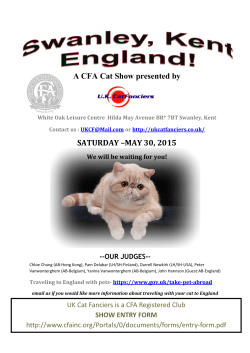
Cat Flu - Doyalson Animal Hospital
is still possible for a vaccinated cat to con- Vaccinations tract “cat flu”, but the infection is not likely to become severe. There are a variety of vaccines available. We recommend that all kittens be vaccinated at 6-8 weeks of age, then boosted at 12-14 weeks and 16-18 weeks. Vaccinations are thereafter yearly and should be maintained. Current vaccinations are essential for any cat that is going to go to a boarding cattery. Vaccines that are routinely given are for Feline Enteritis and Feline Herpes virus Type 1 and Feline Calicivirus. Neither virus is very hardy, FHV-1 will survive in the environment for a maximum of 48 hours. FCV may survive for 7-10 days. In multi-cat households or catteries, vaccination alone may not be sufficient to control the disease. In these cases, quarantine is also required. Disinfection is of limited value as the viruses are spread mainly via aerosol. A large problem faced when introducing new cats to a household is that Additional vaccines are available to some cats are “carriers”. These cats are in- protect against Feline Chlamydia and fected with virus but don't have clinical signs. Feline Leukaemia virus. Cat Flu Client information series They are infectious to other cats only when shedding virus-this can be an intermittent or continual process. 50-80% of cats infected with “cat flu’” will become carriers. Even if your cat contracts cat flu, yearly vaccinations should be maintained as immunity to infection is transient and needs to be boosted. Client information series doyalson animal hospital 423 Scenic Drive Doyalson NSW 2262 Phone: 43 992129 Web: www.centralcoastvet.com doyalson animal hospital Phone: 43992129 tions become involved. Cats tend to be dull Upper Respiratory Infection and depressed with elevated temperatures, in cats of all ages, but is especially severe Specific anti-viral agents have not reluctance to eat and sneezing. Coughing can been available until recently. A new drug be a feature and may progress to pneumonia. recently released is said to enhance the Without treatment the signs tend to resolve immune response of the cat and so elim- in 2-3 weeks. Some cats are left with chronic inate the virus faster. nasal discharge. Treatment can significantly aid “Cat Flu” is a common disease Treatment recovery. FCV tends to cause less serious dis- Most treatment is aimed at suppressing secondary bacterial infections and stimulating eating and drinking. De- in young kittens and purebred cats. A ease, but clinical signs are dependent on the hydration in particular can cause in- number of infectious agents have been strain of the virus involved. Mouth ulceration creased illness. found to cause ‘cat flu’ but most infec- can be a prominent feature causing severe tions are caused by one of two viruses, lack of appetite and drooling. Some strains of break up secretions help with the re- herpes virus type 1 (FHV-1) and feline FCV may cause a lameness and fever syn- covery and comfort of the patient. calicivirus (FCV) drome in kittens, and chronic gingivitis and Clinical Signs tends to cause more severe symptoms, Good nursing care is essential for throat inflammation is also believed to be rapid recovery from “cat flu” Severely ill caused by FCV. cats may require hospitalization for intensive treatment and intravenous fluids. Signs of “cat flu” are similar to those of cold and flu in people. FHV-1 Multivitamins and drugs that Diagnosis Diagnosis is based on clinical signs and Prevention with conjunctivitis and nasal infection. history. Specific identification of the virus may The main method of preventing This causes a clear nasal and eye dis- be done by swabbing the throat of the cat and “cat flu’ is vaccination. As with human flu charge which becomes thickened and then culture and identification by a laboratory. vaccinations, not all strains of the viruses purulent as secondary bacterial infec- This is not a readily available service. which may cause “cat flu’ are covered. It
© Copyright 2025










